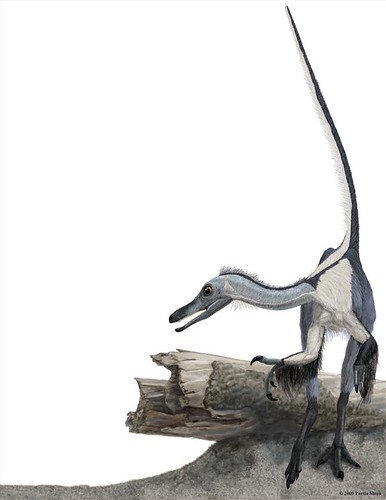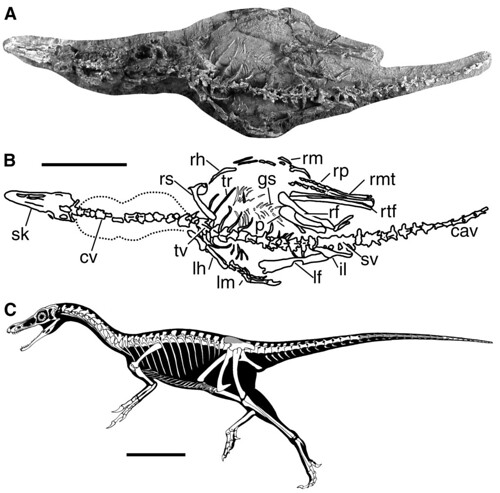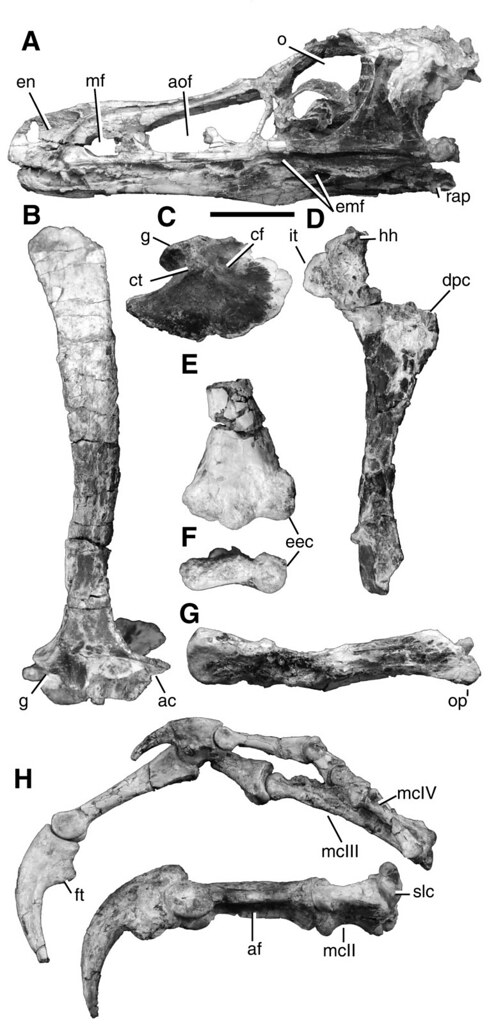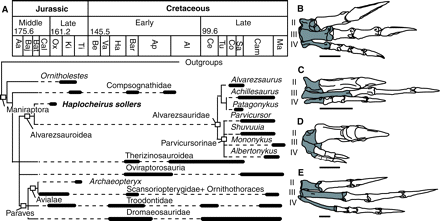tags: evolutionary biology, convergent evolution, paleontology, taxonomy, zoology, basal birds, theropods, dinosaurs, ornithology, birds, Alvarezsauroidea, Haplocheirus sollers, Maniraptora, Archaeopteryx, researchblogging.org,peer-reviewed research, peer-reviewed paper
A Newly Discovered Basal Alvarezsauroid Theropod from the Early Late Jurassic.
Artwork: Portia Sloan [larger view]
DOI: 10.1126/science.1182143
A long-standing scientific debate focuses on the origins of birds: did they evolve from reptiles or dinosaurs? Currently, most scientists think that birds are modern dinosaurs, but because small hollow bones like those of birds and small dinosaurs don't fossilize well, the early fossil record for birds is sparse. However, a new dinosaur species unearthed in China's Gobi Desert strengthens the dinosaur-bird hypothesis and may also provide valuable clues as to how flight evolved.
This new fossil animal, which exhibits characteristics associated with both dinosaurs and birds, further clarifies relationships among theropods, which are a group of meat-eating dinosaurs including velociraptors and Tyrannosaurus rex that gave rise to birds.
"Many dinosaurs are very bird-like and early birds are dinosaur-like," observes Xing Xu from the Institute of Vertebrate Paleontology and Paleoanthropology at the Chinese Academy of Sciences in Beijing.
Similar to birds, the new dinosaur had three toes, a birdlike keel-shaped chest and a long beak, but it had small teeth, like a dinosaur. Dr Xu, who was a member of the research team and a co-author on the paper, added that there is still a lively debate over the exact moment when birds first emerged.
"It is more or less depending on what you call a bird, which is somewhat an arbitrary procedure," said Dr Xu. "For example, Epidexipteryx [a small, feathered dinosaur] could be considered to be the earliest representative of the avian lineage."
The new fossil is the earliest known Alvarezsaur. It provides the first evidence that this group of dinosaurs lived during the Late Jurassic era (roughly 160 million years ago), pushing back their fossil record by 63 million years.
"The fossil [...] confirms our predictions that Alvarezsauridae should have been evolving in the Late Jurassic time period," says Jonah Choiniere, lead author on the paper and a doctoral candidate in paleontology at The George Washington University in Washington DC.
Alvarezsauridae are a bizarre family of bird-like dinosaurs with very short, powerful arms and a large claw on their hands.
"The rest of the members of this group have really short forelimbs with huge muscle attachments, like body-builder arms. The fossil shows the first step in the evolution of this weird arm and claw," explained Mr Choiniere.
Alvarezsaur fossils have been collected since the 1920s, but were so peculiar that the group was first recognized and described only very recently; in the 1990s.
The three-meter (ten foot) long pre-adult dinosaur, christened Haplocheirus sollers ("simple, skillful hand"), is nearly complete and is preserved in exquisite detail (Figure 1).
Fig. 1. Haplocheirus sollers (IVPP V15988). (A) Photograph of holotype in dorsal view. (B) Line drawing of holotype in dorsal view. Dashed line indicates crocodyliform fossil underlying cervical vertebrae. (C) Reconstruction. Gray fill indicates portions of the skeleton that are not preserved. Abbreviations: cav, caudal vertebrae; cv, cervical vertebrae; gs, gastralia; il, left ilium; lf, left femur; lh, left humerus; lm, left manus; p, pubis; rf, right femur; rh, right humerus; rm, right manus; rmt, right metatarsus; rp, right pes; rs, right scapula; rtf, right tibia and fibula; sk, skull; sv, sacral vertebrae; tr, thoracic ribs; tv, thoracic vertebrae. Scale bar: 25 cm. [larger view]
DOI: 10.1126/science.1182143
"Haplocheirus is a transitional fossil, because it shows an early evolutionary step in how the bizarre hands of later Alvarezsaurs evolved from earlier predatory dinosaurs," explained Mr Choiniere.
The specimen was discovered after a team member noticed the pelvis on the earth's surface in river-lain rock in northwestern China, a region well-known for its Late Jurassic fossils. The remainder of the fossil was only inches down, was collected in 2004 during a series of expeditions co-led by Dr Xu and James Clark, a paleontologist at The George Washington University who is advisor to Mr Choiniere and another co-author of the study.
"The primary goal of our expeditions was to find evidence of the theropod dinosaurs closest to birds, and the discovery of Haplocheirus is one of our major discoveries," said Dr Clark. "This spectacular skeleton shows how the strange arms of Mononykus and other alvarezsaurs evolved from a more typically theropod grasping hand." (Figure 2).
Fig. 2. Haplocheirus sollers (IVPP V15988) skull and forelimb elements. (A) Skull in left lateral view. (B) Right scapula in lateral view. (C) Right coracoid in lateral view. (D) Right humerus in lateral view. (E) Left distal humerus in flexor view. (F) Left distal humerus in distal view. (G) Right ulna in medial view. (H) Left manus in lateral view, with digit II separated from manus. Abbreviations: ac, acromion process; af, axial furrow; aof, antorbital fenestra; cf, coracoid foramen; ct, coracoid tuberosity; dpc, deltopectoral crest; eec, ectepicondyle of humerus; emf, external mandibular fenestrae; en, external naris; ft, flexor tubercle; g, glenoid; hh, humeral head; it, internal tuberosity; mcII to mcIV, metacarpals II to IV; mf, maxillary fenestra; o, orbit; op, olecranon process of the ulna; rap, retroarticular process; slc, semilunate carpal. Scale bar: 4 cm.
DOI: 10.1126/science.1182143
Haplocheirus's hands each had three strong fingers, with the middle digit being "much more robust than the others." Choiniere proposed that the three claws could fuse over evolutionary time into the single claw of the later Cretaceous alvarezsaurs, further confirming the long-held view that birds emerged from the Maniraptoran "hand snatcher" clade (Figure 3).
The researchers think its distinctive claw may have been used for tearing into termite mounds.
"It may have had a very general diet, tackling smaller animals like lizards, very small mammals and very small crocodile relatives," explained Mr Choiniere. "It was a lightly built animal and could run very quickly."
Fig. 3. Phylogenetic relationships of Haplocheirus sollers and hand comparisons of selected theropods. (A) Simplified, temporally calibrated cladogram of the strict consensus of 69 most parsimonious trees produced in this analysis. Thick lines with rounded end caps indicate stratigraphic range of known taxa. Thin black lines with square ends indicate phylogenetic relationship. Dashed lines represent ghost lineages implied by the stratigraphic distribution of fossils with respect to the phylogenetic relationships shown here (note the exceptionally long ghost lineage for Alvarezsauroidea). Arabic numerals indicate ages in millions of years before present. Boxes represent named clades. (B to E) Reconstructed theropod mani scaled to digit two length. (B) Allosaurus fragilis after Madsen (40). (C) Haplocheirus sollers (IVPP V15988). (D) Shuvuuia deserti after Suzuki et al. (31). (E) Deinonychus antirrhopus after Ostrom (41). Metacarpal elements are shaded, dashed lines in (D) indicate inferred digital elements. Abbreviations: II to IV, manual digits II to IV; Aa, Aalenian; Baj, Bajocian; Bat, Bathonian; Cal, Callovian; Ox, Oxfordian; Ki, Kimmeridgian; Ti, Tithonian; Be, Berriasian; Va, Valanginian; Ha, Hauterivian; Bar, Barremian; Ap, Aptian; Al, Albian; Ce, Cenomanian; Tu, Turonian; Co, Coniacian; Sa, Santonian; Cam, Campanian; Ma, Maastrichtian. Scale bar: 5 cm (B), 4 cm (C and E), 0.5 cm (D).
DOI: 10.1126/science.1182143
Haplocheirus is important for several reasons. First, it lived nearly 20 million years before Archaeopteryx, a primitive feathered, flying bird. Due to its antiquity as well as its close physical similarity to birds, Haplocheirus definitively shows that Alvarezsaurs evolved quite separately from the ancestors of birds, further strengthening the dinosaur-bird link.
Second, because of its close resemblance to birds, Haplocheirus indicates that there was a lot of evolutionary experimentation surrounding the basic bird body plan and building upon several avian characters.
"Although it certainly couldn't fly, the [Alvarezsauridae] were originally thought to be birds," reports Mr Choiniere. "And although they're closely related to birds, they clearly weren't birds at all."
Haplocheirus, which is the largest Alvarezsaur unearthed so far, was big for a bird but small for a dinosaur. Because it is the earliest member of the Alvarezsaur lineage, it also shows how some dinosaurs decreased to bird size over time.
Source:
Choiniere, J., Xu, X., Clark, J., Forster, C., Guo, Y., & Han, F. (2010). A Basal Alvarezsauroid Theropod from the Early Late Jurassic of Xinjiang, China. Science, 327 (5965), 571-574 DOI: 10.1126/science.1182143
- Log in to post comments





Awesome news, and fantastic write-up. Thanks.
There have been some really fascinating fossils coming out of China in the past few years. I daresay there'll be more excitement to come.
Also makes me wonder what other marellous fossil beds will be found in the future. Despite it's billions of people the Earth is still a very large place with plenty of places to look.
Yong write that title for ya?
I'm confused. I thought the flame war was between ScienceBlogs and Nature Network at the moment. Has Ed started a new one whilst I wasn't looking?
I notice they end up talking about how "confusing" it is to identify what's a bird and what's not.
I say, if it possessed a short, pygostyled tail-fan, asymmetrical wing feathers, an ability to fly,a beak, and lived in the Mesozoic, it's a bird. Otherwise, it's a very bird-like dinosaur, or (if about 4/5 of these apply) some bizaare offshoot.